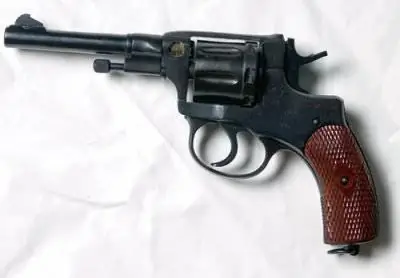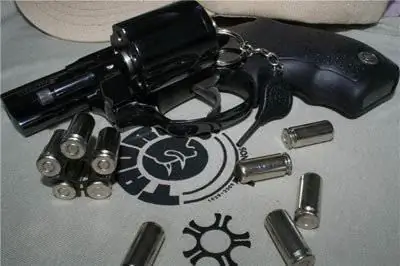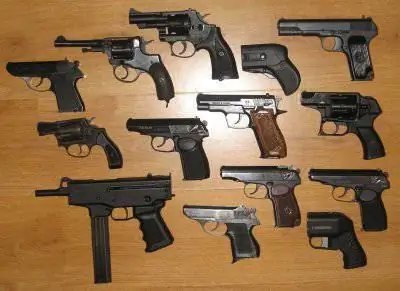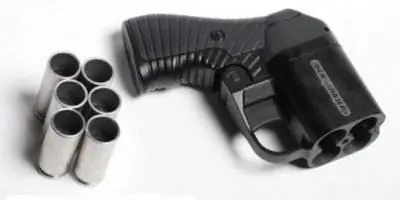- Author Matthew Elmers [email protected].
- Public 2023-12-16 21:49.
- Last modified 2025-01-24 09:17.
Recently, there has been an active discussion of the legalization of short-barreled weapons among the civilian population. I will not go into details of whether it is worth doing, but one moment in this all caught my attention. Namely, the consideration of weapons of traumatic action as a kind of test for the readiness of people for more serious firearms of pistols and revolvers no longer with rubber bullets. Let's try to figure out why people are skeptical about "traumatic", and also why it cannot be considered a test for the readiness of owning a full-fledged short-barrel. I must say right away that the article is completely subjective, so many points may not coincide with the opinion of many readers.

First of all, it is necessary to consider the issue of treating a weapon of traumatic action not as a weapon, but as something frivolous. After all, it is precisely this attitude towards traumatism that is the main reason that people grab onto it at the first opportunity, which quite often ends sadly. No matter how they hinted to us that we are sheep, to whom it is dangerous to even give a shovel, but such a frequent and not always justified use of traumatic weapons is not at all due to our mentality or something else, which they put the main reason for our invented "wildness" … And the point here is not that the character is hot-tempered and not that the person does not foresee the consequences of his actions. The reason lies precisely in the attitude towards weapons of traumatic action. Once upon a time, the first traumatic pistols and revolvers were really "pukers" with a kinetic energy of a bullet of about 30 Joules. Agree that such a perversion cannot be considered a weapon, even at a stretch. In addition to these samples, there were older and more efficient OSA, but due to their non-standard design, in which an electric current is used to ignite the initiator composition, they did not receive wide recognition, although they were really effective samples, which they are now. But something I deviated from the main idea. And the main idea is that the effectiveness of the first traumatic pistols and revolvers of classical designs was very low, respectively, this weapon was also treated. But the weapon of traumatic action developed, the muzzle energy grew, but the attitude towards traumatism remained the same. This is proved by the fact that in most cases would-be shooters say that they wanted to scare and did not want to cause serious injury. Even those people who, on duty, closely communicate with full-fledged weapons, are skeptical of traumatism. So, I recall one of the incidents on the road, when a person had a service weapon and a traumatic person with him, but to sort out the relationship, he chose the traumatic one. At the same time, there were enough witnesses so as not to worry about their identification, especially since there was a car belonging to the shooter nearby.

Of no small importance in such a frivolous attitude towards weapons of traumatic action is the fact that for a very long time people did not trust at least relatively effective means for self-defense. Gas cartridges, stun guns, etc. have developed the opinion among people that since they are trusted to use it, it means that these items are safe. And if we take into account also gas pistols, for the effectiveness of which, in my opinion, they should be sold freely, and to get it, you have to run around a dozen offices. And then a hitherto unseen toy appeared that really shoots, and even looks like a normal pistol or revolver.
This is how we approached the topic of the appearance of traumatic weapons. In my opinion, most models of modern traumatics are very, very far from the very concept of "weapon of traumatic action", and the appearance of pistols and revolvers is to blame for this, no matter how silly it sounds. I'll try to explain. From the very appearance of traumatic weapons on the market, for some unknown reason, people longed for the maximum similarity of traumatic weapons with a combat analogue, and many even wanted to spit on the effectiveness of the weapon, for them the showiness was more important. Such a weapon, due to its appearance, is very limited in the maximum possible caliber, since it is impossible to shove in something that is not pushed in, and if you increase the caliber to normal for trauma, the appearance of the pistol will become such that even Arnie, aka the Terminator, will be afraid of it. So the consumer very quickly tasted that there was the first traumatic and demanded a more effective weapon, but since the caliber could not be increased, the problem of efficiency was solved by increasing the powder charge, which made the ammunition really more effective, but did they remain traumatic … What is traumatic ammunition? In my opinion, this is a cartridge, the projectile of which, under no circumstances, should inflict penetrating wounds. Does a ten-millimeter ball with a kinetic energy at the exit of the weapon barrel equal to 80 Joules meet this requirement? The answer to this question can be found in hospitals.

Of course, it will not be possible to hit the enemy with a guarantee, it's all a matter of chance, but this is precisely the main danger of a weapon of traumatic action. So, when shooting from a combat pistol, you clearly understand what the consequences will be from the hit, but with traumatism, not everything is so clear. Will she pierce the striker's down jacket and warm sweater? What if he's wearing a T-shirt instead of a sweater? Let's add to this the questions "Will I get in?" and "where will I go?" as the accuracy of the traumatic weapon is legendary. It is interesting that for the use of traumatic weapons, you can sit down even when using the weakest ammunition, which can in no way inflict an open wound. So, you can aim at the chest, and get into the eye, and so it turns out that traumatism is a ticket to places of imprisonment, which has been proven by many. A traumatic weapon is a weapon that, due to its design, cannot be completely controlled by the shooter, which means it has no right to exist.

I also cannot ignore the question of the complete similarity of traumatics with a combat analogue. A striking example of the phenomenon of mass insanity on the basis of bringing the appearance of a traumatic weapon to the form of a combat one can serve as PM-shaped samples. How many "beards" have been welded on, how many safety brackets have been worn off, you can't even count it, but why is all this? I perfectly understand those people who do it simply out of "love for art", that is, simply from aesthetic considerations that have no practical implications. But when someone begins to prove that the complete identity of the appearance of a traumatic pistol with a combat progenitor will save him in a critical situation, then he wants to twist his finger at his temple. Let's be realistic and estimate what the likelihood of running into a man with a military weapon on the street is. The probability is clearly very, very low, because if an attacker sees that something similar to a pistol is directed at him, then he assumes that it is traumatic, pneumatics, gas weapons - anything, but not combat. And by the way, most of the attacks take place in the dark, so all the work on filing the safety bracket to give it a more elegant shape is meaningless, since they simply will not be seen. Personally, in the event of an attack, I would prefer that I have something effective in my hands, while its appearance would be the last thing I care about. Yes, even a rubber yellow duck, let it be in your hands, if it knows how to shoot full-fledged ammunition.

There is one more important point in the question of the appearance of the weapon. The fact that many bring their traumatics to a complete external resemblance to combat models is one thing, but the fact that many of the models of traumatic weapons have been converted from once combat weapons is another interesting question. In particular, there are two points here: the first is the cost of such a rework, since what is taken from the warehouses, the second point is how correct it is to spoil the same Nagans, which, in my opinion, are of historical value. By the way, of all the alterations, only the PM-T and TT-T can be called relatively effective, everything else deteriorates so much that it is not even quoted as a traumatic weapon.
And now the most important thing. It seems that the state took care of its population, gave it a relatively effective means of self-defense, but is that so? Based on everything written above, it was not a means of self-defense that fell into the hands of people, but a means that helps to sit down for an indefinite period from this very self-defense. We will not touch on the issue of imperfect laws, this is a separate topic, but why make a weapon for self-defense, which one time turns out to be ineffective, and another time can kill an attacker? And it seems that one can even observe that they are making concessions, making traumatic weapons more powerful, making them from combat models, seeing an interest in such alterations of the population. But the real reason is not concern for the population at all, but banal profit. So, for the sake of interest, you can see how much PM-T costs now due to its rarity, and I will pretend how much it cost to adapt a full-fledged sample for traumatic cartridges.

But a really effective and relatively safe trauma is very simple in design. Just for example. Take a rubber bullet made of soft rubber with a diameter of, say, 20 millimeters, weight it not with an all-metal core, but with lead shavings, pack it all due to the ability of the rubber to deform into a sleeve with a diameter of 15 millimeters, and that's it, a powder sample so that the bullet has an output of 120-150 Joules and that's it. Effectively, without penetrating wounds, lethal outcome only in the head and in exceptional cases. But after all, it is much easier to spoil the once combat model, which had its own history, fought, but there is no respect for metal, as well as for people.
So, when someone says that they gave traumatics in order to check whether it is possible to give a full-fledged weapon, then this, in my opinion, is absolute nonsense. They gave it only to fill my pocket and nothing more, and there can be no question of any kind of verification. It is possible to check readiness only with the permission of short-barreled weapons. And not in stages, as many suggest: first allow to store, then wear, then apply, or even in some more stupid scheme, but immediately. But you need to start by revising the laws related to self-defense.

If we talk about what types of weapons of traumatic action can be called acceptable, then these are, first of all, "special-like" ones. First of all, it should be noted that the price for this weapon is definitely lower than for other samples, although the cartridges are more expensive. The second point is the "correct" caliber of these samples, although the metal core in the bullet is definitely overkill. Thirdly, ease of maintenance, by and large, all that a gun needs from its owner is alcohol-containing liquids, and better pure alcohol in unlimited quantities. Well, despite the skeptical attitude towards "electronic" pistols, they are quite reliable, since they are simple in design. But, despite the existence of these pistols, they still cannot be attributed to the weapon of traumatic action in the form in which it seems to me, if only because of the presence of a metal core in the bullets. Although not so long ago, new 18x45RSh ammunition appeared, in which the bullet is a rather large rubber ball weighted with metal shavings, these ammunition is almost perfect.
So, I say with confidence that a traumatic weapon, whatever you call it, is an absolute evil, and if the question of the legalization of a short-barreled full-fledged weapon looks somewhat unclear and has its pros and cons, then the fact that a traumatic person needs to be prohibited is a fact. Well, at least I think so. Or to make it really what it should be, but, excuse me, when a rubber bullet from a distance of 5 meters, having lost part of its initial velocity, pierces the wall of an enamel pan, there is something to think about. Although this, of course, does not apply to all types of traumatic weapons and cartridges for them.
P. S.:I have a negative attitude to the legalization of short-barreled weapons, since I do not believe that the licensing system will work correctly, and the laws will become less stupid.






